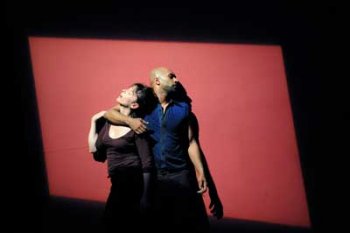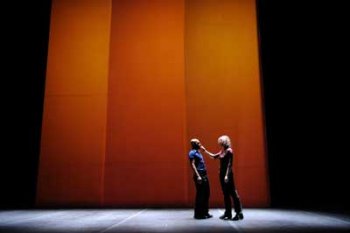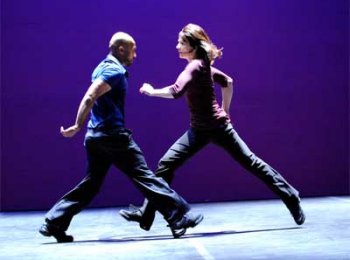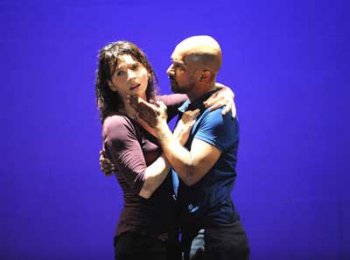
|   |

|   |
Akram Khan and Juliette Binoche's 'In-I' - Dr Sunil Kothari e-mail: sunilkothari1933@gmail.com Photos: Tristram Kenton September 20, 2009  Venue: BAM Harvey Theatre, New York Date: Tuesday 15th September 2009 Event: Akram Khan and Juliette Binoche's co-directed In-I' dance theatre. I arrive by 7 pm taking Lexington Express train, get off at Nevins Subway and walk two blocks on Fulton Street. In the foyer, Fatima welcomes me and gives my press ticket with press kit. I meet Farooq Chaudry, producer, dancer, promoter of Akram Khan and Akram Khan Company's tour manager, young Christina. She tells me that after the performance Akram will see me backstage. Joe Melillo, the Director of BAM and Next Wave, welcomes me. After few pleasantries, I locate Uttara Asha Coorlawala, the dancer and Professor at Bernard College, waiting for me. We take our seats. This is the same theatre where Peter Brook had staged his Mahabharata, featuring young 13 year old Akram, vivacious and beautiful Mallika Sarabhai as Draupadi. It was here that Chandralekha's Raga was performed. I am full of many memories. But I start reading program notes. For more than a year, In-I has been touring in Europe, Asia, China, Canada and this was American premiere. Joe had informed me about it well in advance. I was looking forward to seeing it. After I saw Sacred Monster by Akram at Sadler's Wells, London, two years ago with the French ballet dancer, the superstar Sylvie Guillem, I was seeing his collaboration with Academy Award winner French actress Julliete Binoche. There was a buzz about their performing together. An actor dancing, with a dancer acting. A challenge they accepted and worked towards resolving several conflicts, issues in a production that is riveting, engrossing and keeps one on the edge of one's seat. Anis Kapoor's set with huge square as a backdrop and imaginative mood lighting, enhances the theme symbolically, a wall between two human beings, a man and a woman, wanting to be together, a duet, examining the complexities and chronological relationship, at times pleasant and at times quite claustrophobic, cruel, suffocating, agonizing, elements of jealousy, to discover who they are In-I.' 

Juliette is not a dancer, she admits innocent of the formal dance training' making Akram to rethink his work process completely, and he did not want to portray her as a new modern dance talent; she with her naturalistic acting had to encounter Akram, who knew he cannot act the way she acts. Out of these challenges with improvisation they evolved a dance language and have succeeded in what they say: What we are trying to say is. That doesn't mean there isn't a dancing body within actress, or an actor within the dancer.' A dance theatre piece, the duet uses dialogues, and dance movements, creates tensions, humour, vignettes of daily life, irritations, using toilet, the man wanting to get rid of the woman, she clinging to him, both coming closer and often wanting to get away from each other, the violence, the sadistic tones, the existential dilemma, the inevitable questioning are enacted with intensity and terrific energy. Improvising, they have created a piece which indeed is amazing. Juliette admits that she does not want to be a dancer and after the performances are over, she would be back to the films. Akram does not attempt to be an actor. But for both of them, it indeed is an exploration of dance and acting. 

In one sequence, Akram throws her on the wall and she is stuck there. A clever theatrical device. She recounts the jealousy the man had experienced seeing her photo with a friend, her head resting on his shoulder, he suspecting her relationship with the friend - the way Juliette says it is agonizing. When she falls and runs behind the stage, returns to leave the man, the denouement appears tragic. They cling to each other and lights fade. It was obvious that Akram and Juliette are from different worlds, with different interpretations, different in everything. And they found a language of intimacy. It took for them a long time, at times very joyful as they admit and at times very naked emotionally. "But it brings humanity out of us," says Akram.  When the performance concluded, there was a rousing applause, standing ovation, and more than six curtain calls. The volcanic energy with which Akram dances is mind-boggling, mesmerizing. At 35, the energy level is extremely high, charged, he moves with grace and power, making one wonder what he taps to create these dynamic images! Since Juliette did not want to prove that she is a superb dancer, she did not fall into any of the traps and moved in synch with Akram with elfin grace - their duet was perfect. It must have been extremely hard to achieve that level of perfection for an actress to match Akram's dance. However, it was seamless, and engrossing. After the performance, we waited for more than thirty minutes. With such demanding dancing of high voltage, to unwind for Akram must have been a task. He arrived cheerfully and we hugged each other. He looked smaller than what he appears on stage. Smiling, cheerful and humble, Akram wins over his admirers. He greeted Uttara Asha Coorlawala and Ella Baff, the Director of Jacob's Pillow Festival and we soon started talking animatedly. He conveyed Kumudini Lakhia's regards to me. She is currently choreographing dance for two young male dancers for Akram Khan's Festival to be mounted at Sadler's Wells theatre under Akram's directorship form 16th November featuring himself in classical Kathak, Aditi Mangladas and her troupe, Priyadarshini Govind in Bharatanatyam, Shantala Shivalingappa from Paris in Kuchipudi, the two male Kathak dancers and others. "Will you come?" He invites me. I know I cannot as I am going to be in Guwahati, Assam, working on Sattriya dances. So I wish the festival all the best. We decide to meet for a long chat for an interview and wish him all the best for his incredible dancing and performances for the next nine nights. He has a formidable tight schedule performing every night.  Dr. Sunil Kothari, dance historian, scholar, author, is a renowned dance critic, having written for The Times of India group of publications for more than 40 years. He is a regular contributor to Dance Magazine, New York. Dr. Kothari is a globetrotter, attending several national, international dance conferences and dance festivals. He has to his credit more than 14 definitive works on Indian classical dance forms. Kothari was a Fulbright Professor and has taught at the Dance Department, New York University; has lectured at several Universities in USA, UK, France, Australia, Indonesia and Japan. He has been Vice President of World Dance Alliance Asia Pacific (2000-2008) and is Vice President of World Dance Alliance Asia Pacific India chapter, based in New Delhi. A regular contributor to narthaki.com, Dr Kothari is honored by the President of India with the civil honor of Padma Shri and Sangeet Natak Akademi award. He recently received the Senior Critic award from Dance Critics Association, NYC. |